How to train and build your own coffee sensory system in the common language of the coffee industry
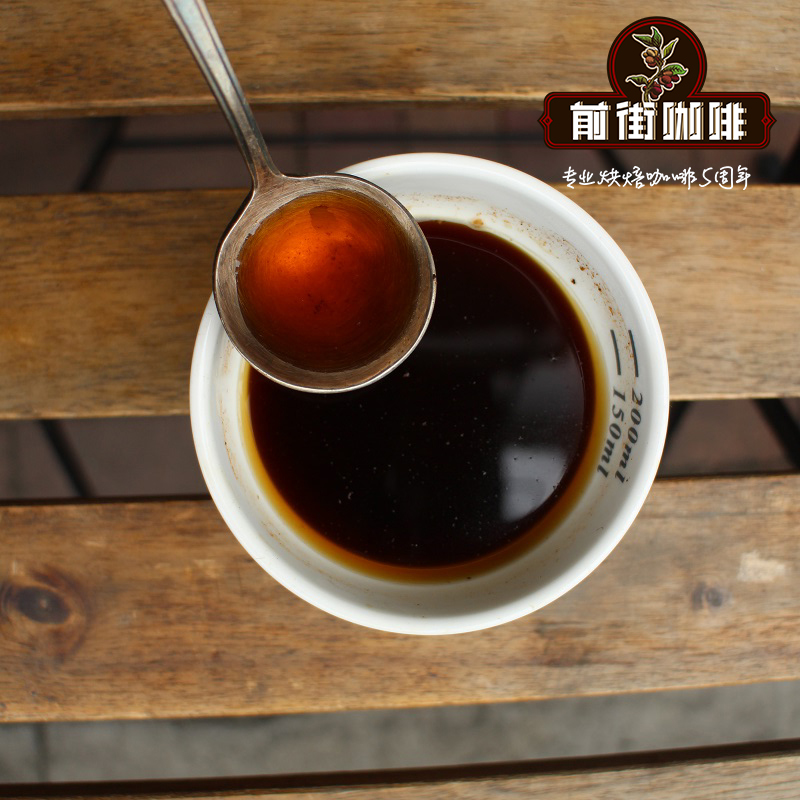
Professional coffee knowledge exchange more coffee bean information please follow the coffee workshop (Wechat official account cafe_style)
As coffee is gradually recognized, the promotion of boutiques in stores is also born in response to the trend, we also began to ask the source, we regard coffee as a culture.
The rise of boutique hand-brewed coffee undoubtedly does not experience the needs of the market and the needs found by stores. The bar of the store is more and more self-lowering, which is no longer the design of the early bar one foot higher. The bar design adds seats, so that customers can more intuitively feel the fun of the production process. And the barista is also vivid, warm and cheerful to communicate with others. Come on, smell the dried fragrance, the outstanding scent of jasmine, roses and lemon. Guide the guests to drink, what will you feel at the entrance, what is in the coffee? The guest will be pleasantly surprised to tell you what it feels like when he drinks it. Whether it's interesting or not, your loyal fans will not only support you, but also drive his friends to study together.
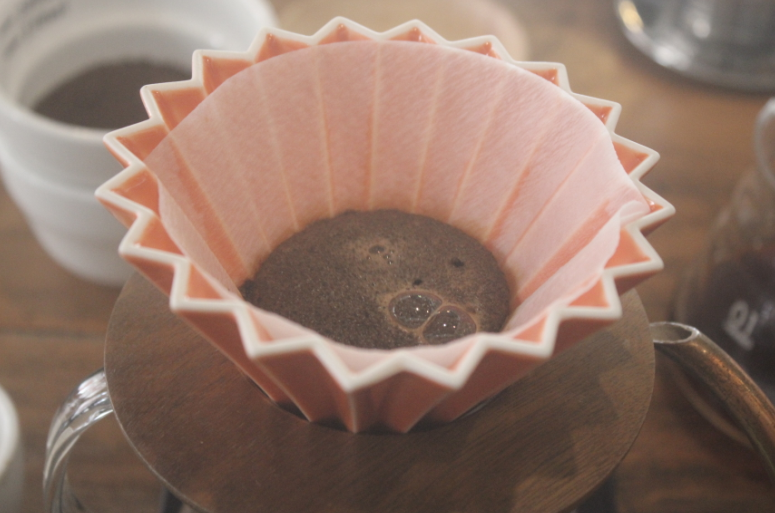
We often think that tasting food is based on the sense of taste, but in fact, some aromas are put into the mouth and reach the nose, while others are sensed by touch, and studies have also confirmed that every sense of taste, including sight, hearing, touch, smell and taste, affects the taste.
Memory is the persistence of psychology in time, and memory is inseparable from memory in the process of tasting, whether it is perception, discrimination, monitoring, and comparison.
Although we are not cup testers and do not need such professional training, try to smell it with your nose before taking your first sip of coffee.
Because when tasting food, the sense of smell is as important as the sense of taste, just like when you catch a cold, your nose is stuffy and the food is boring.
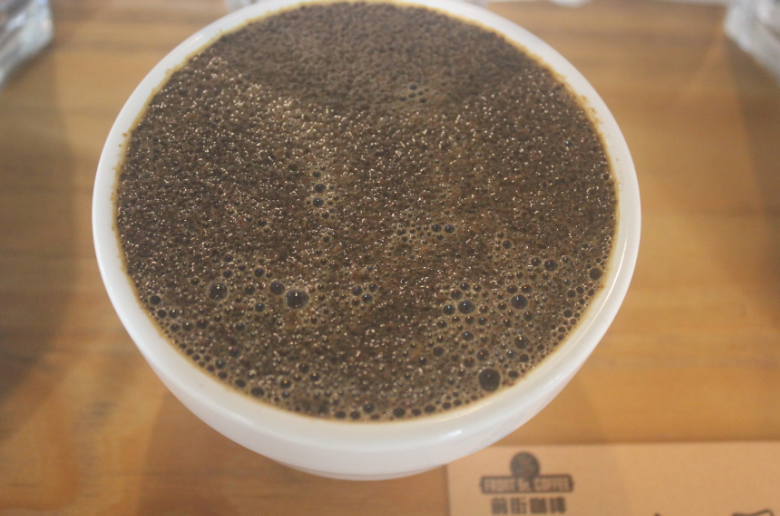
Smell is a volatile substance, invisible, can not be touched or seen, can only approach it and feel it. Remembering the smell of your surroundings is an exercise that needs to be accumulated in daily life. Usually, we should consciously remember the smell of the surrounding living environment: tarmac roads, gardens, woods, seasoning cans in the kitchen, vegetable markets, and so on. The purpose of this exercise is to classify all kinds of aromas-floral, fruity, nutty, balsam, scorched odor, etc. Finally, be able to understand the common characteristics of each smell type.
The aroma of freshly brewed coffee is the first feeling when tasting it. If you smell the aroma through your nose, you can feel the ever-changing flavor of coffee. In a cup of coffee, you can often smell a variety of aromas: flowers, fruit acid, earth herbs, caramel and so on. This is the charm of coffee.
The drive of the sense of smell will draw the relevant sense of taste. For example, if you smell berries and caramel, then there must be something in the cup. What is it? it is clear why the outstanding flavor is gone, why the aroma is so weak, and the taste in the cup is not satisfactory. Charming flower aroma, fruit aroma, no longer exist. At this time you will start the memory bank, which is supposed to start the memory bank, what is supposed to be in it, what kind of baking expression you want to do, depends on your olfactory memory.
We all know that when coffee molecules begin to degrade, polymerize and volatilize during baking (Mena reaction), there are many flavors in the aroma, so we always sample and adjust the roasting by our senses, vision and smell.
Sometimes you feel something you are familiar with, but you can't say it. Does it bother you very much? If you open the memory of smell and combine it at this time, is it a lot easier?
For example, when you smell durian, if you have eaten it, the taste will turn on. Because the sense of smell is enough to drive the memory of taste! And taste can also be driven by taste. It all depends on your memory and the message expressed in the cup. Because smell and taste interact.
For taste training or memory, improve our discrimination ability.
Keep drinking, and keep remembering. It takes a process of accumulation. The so-called accumulation process is also a painful training process, spending a lot of money, using a lot of time, quantitative change to bring qualitative change.
Taste is one of the most important senses for us to taste food. From putting it in the mouth to pushing it into the throat, this short distance of 10 centimeters dominates the important way to feel the taste of food.
The feeling of taste depends most on the tongue. The four basic tastes include bitter, salty, sour and sweet. Different areas of the tongue have different sensitivity to taste, and taste buds distributed throughout the tongue can feel all kinds of taste.
The taste buds on the tongue can quickly connect all the passing food to the brain immediately, record all the tastes and store them, and even remember the taste of a certain food when it comes to it, which is the reason for "hoping for plums to quench thirst".
So when drinking coffee, don't swallow it in a hurry, leave it in the front of your mouth and let the detector on your tongue analyze the different tastes: sour, sweet and bitter? What's the acid? Sour before sweet or bitter before sweet?
Then let the smell of coffee bloom in the mouth and nose, and after swallowing, you can feel the aftereffect of the coffee liquid flowing down the throat, as well as the aroma left in the mouth, as the saliva swallows, you will feel the aftertaste gushing out of the throat.
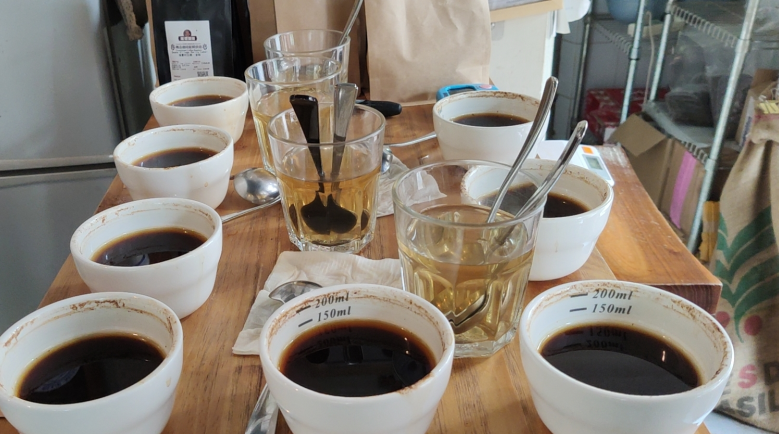
We often use some adjectives to describe food: crisp, soft, sticky, Q-flick, silky. In addition to the ups and downs, we also care about the feelings of our tongue, lips and teeth. This is the taste of the food. At the same time, our tongue will also sense the temperature of the food. The taste and temperature experience all come from the sense of touch, including astringent, numb and spicy feelings.
When drinking coffee, we will feel the "consistency" after the entrance of the coffee, including a light water-like light, or thick taste. Some coffees make people feel "thick", while others feel silky and smooth.
Different brewing methods will also affect the consistency of coffee, such as hand-brewed coffee filter paper will filter out the coffee oil, drink more light, taste Italian coffee can feel the thicker oil.
The daily sense of taste and smell can be trained by eating more fruit and smelling the aroma of fruit. if you want to train the sense of taste more deeply, by smelling the fragrance bottle and freshly ground coffee powder, the dry fragrance, the wet fragrance and the flavor contrast smell too much, and you will also get dizzy. you can smell the lid first, then smell the oil, swing left and right to let the nasal cavity fully feel the smell, contrast the smell, this can deepen the discrimination, however, no matter which kind of smell bottle Hard practice is bound to improve the ability of olfactory discrimination.
At present, there are two major scent bottles on the market, one is the 36-flavor Le Nez du Cafe (coffee nose) made by French EditionJean Lenoir, and the other is the 100flavor Coffee Flavor Map (coffee flavor map) produced by Scentone in South Korea this year.
Le nez du cafe coffee nose is attached first.
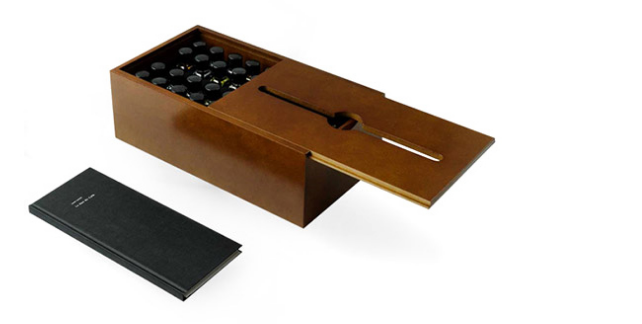
36 flavor coffee smell bottle:
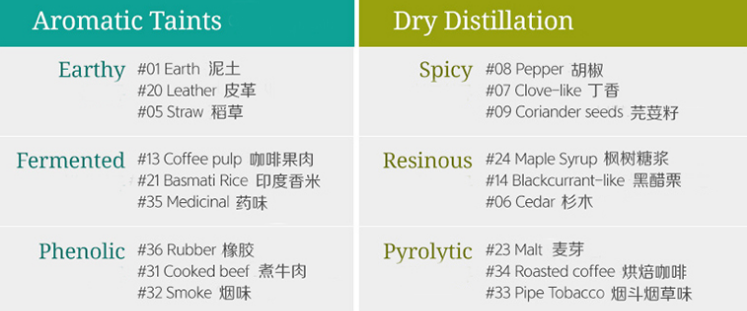
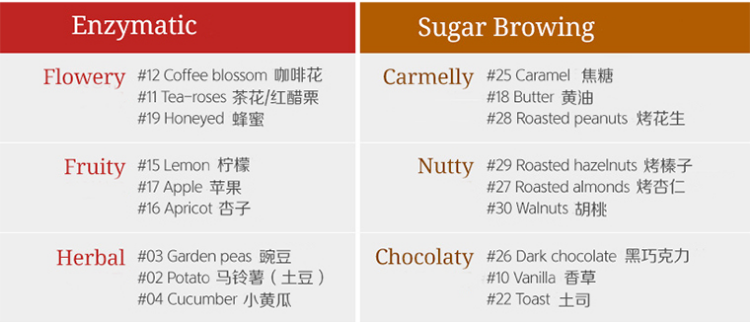
One, Enzymatic (enzymatic group)
(fruit): lemon Lemon, apple Apple, apricot Apricot
(vegetables): potato Potato, cucumber Cucumber, pea GardenPeas
(nectar): coffee flower Coffee Blossom, perfume rose TeaRose, honey Honeyed
Second, Sugar Browning (caramel group)
(four nuts): roasted almond Roasted Almonds, roasted peanut RoastedPeanuts, roasted hazelnut Roaster Hazelnuts, walnut Walnuts
(three desserts): caramel Caramel, dark chocolate BlackChocolate, vanilla Vanilla
(two meals): toast Toast, fresh butter Freshbutter
Third, Dry Distillation (dry distillation group)
(seasoning): pepper Pepper, vanilla seed CorianderSeed, clove Clove-like
(beverage raw materials): blackcurrant Black Currant-like, maple syrup MapleSyrup, malt Malt
(herbal processing): roasted coffee Roasted Coffee, cut tobacco PipeTobacco, Chinese fir Cedar
Fourth, Aromatic Taint (defect group)
(wet and fishy): soil Eathy, straw Straw, medicinal Medicinal
(dry stimulation): rubber Rubber, leather Leather, smoke Smoke
(pleasant fragrance): coffee pulp Coffee Pulp, fragrant rice BasmaticRice, roast beef Cooked Beaf
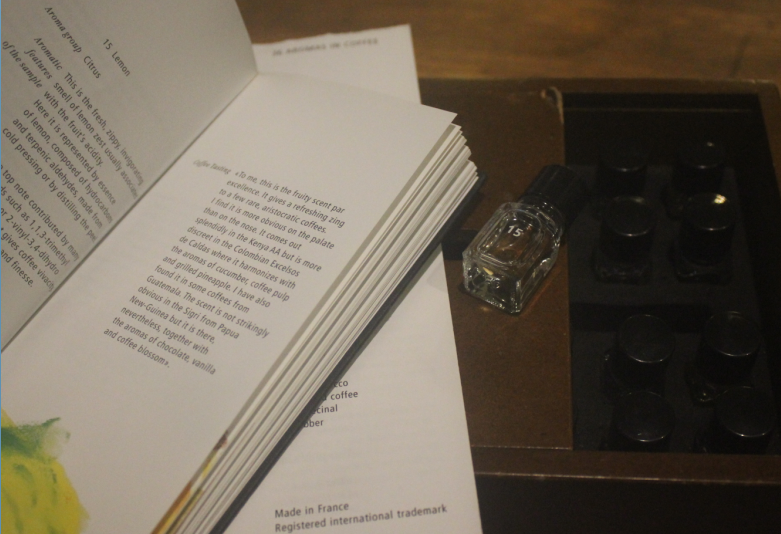
Coffee Flavor Map (Coffee Flavor Map)
The Coffee Aroma Kit T100, also known as Coffee Flavor Map, was unveiled for the first time at the 2016 SCAA Exhibition.
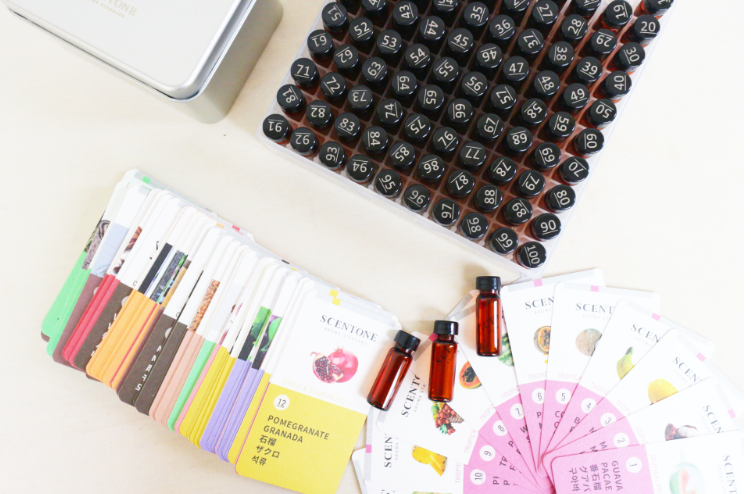
1. Guava guava 2, mangosteen mangosteen 3, mango mango 4, banana banana 5, coconut coconut 6, passion fruit passionfruit 7, watermelon watermelon 8, papaya papaya 9, tropical fruit tropical fruit
10. Pineapple pineapple 11, Hami melon melon 12, pomegranate pomegranate 13, litchi lychee 14, aloe aloe 15, strawberry strawberry 16, blueberry blueberry 17, raspberry raspberry 18, cranberry cranberry 19, BlackBerry blackberry
20. Acerola cherry acerola 21, Brazil berry acai berry 22, blackcurrant blackcurrant 23, white grape white grape 24, musk grape muscat 25, grape grape 26, lemon lemon 27, orange orange 28, lime lime 29, grapefruit citron (yuja)
30, grapefruit grapefruit 31, pear cheinesepear 32, apple apple 33, wooden pear Chinese quince 34, cherry cherry 35, black cherry dark cherry 36, peach peach 37, plum plum 38, apricot apricot 39, jujube jujube
40, hazelnut hazelnut 41, walnut walnut 42, pine nut pine nut 43, almond almond 44, peanut peanut 45, pistachio pistachio nut 46, sesame sesame 47, red bean red bean 48, malt malt 49, Guoba scorched rice
50. Roasted coffee beans roasted coffee bean 51, caramel caramel 52, brown sugar brown sugar 53, honey honey 54, maple syrup maple syrup 55, cream chocolate milk chocolate 56, dark chocolate dark chocolate 57, mocha mocha 58, cream cream 59, butter butter 60, yogurt yogurt
61. Cheddar cheddar cheese 62, Pine pine 63, Hawthorn crataegus 64, Basil basil 65, Thyme thyme 66, Earl Black Tea carl grey 67, Rose rose 68, Jasmine jasmine 69, Sophora acacia
70, elderflower elderflower 71, lavender lavender 72, bergamot bergamor 73, chrysanthemum chrysanthemum 74, hibiscus hibiscus 75, eucalyptus eucalyptus 76, cinnamon cinnamon 77, vanilla vanilla 78, nutmeg nutmeg 79, clove clove
80, cardamom cardamom 81, star anise star anise 82, cumin cumin 83, black pepper black pepper 84, garlic garlic 85, ginger ginger 86, soy sauce soy sauce 87, mustard mustard 88, mayonnaise mayonnaise 89, pumpkin pumpkin
90, tomato tomato 91, cucumber cucumber 92, mushroom mushroom 93, taro taro 94, GE kudzu 95, ginseng ginseng 96, colored pepper paprika 97, musk musk 98, amber amber 99, tobacco smoke 100, roast beef savory beef
END
Important Notice :
前街咖啡 FrontStreet Coffee has moved to new addredd:
FrontStreet Coffee Address: 315,Donghua East Road,GuangZhou
Tel:020 38364473
- Prev
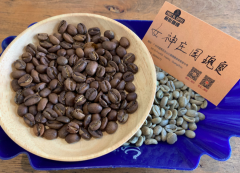
Notes on searching for beans on Qianjie Street | Special report on Rose Summer of Multi-Tower Goddess Manor in Costa Rica
CostaRicaDotaElDiosaGeisha Costa Rica multi-tower goddess manor rose summer origin: Costa Rica CostaRiCa production area: Tara Zhu Tarrazu manor: multi-tower goddess manor DotaEIDiosa varieties: rose summer Geisha
- Next

The difficult transition of Coffee in Colombia | A country from growing cocaine to growing coffee
For more information on coffee beans, please follow the Coffee Workshop (Wechat official account cafe_style) Colombia, the second largest coffee producer in the world, where the silky taste of Colombian coffee is irresistible. Moreover, it has the best balance and soft taste.
Related
- Customers have "changed" Manner's new products! Shop assistant: Please don't mess around!
- Remove sockets in customer areas at Starbucks stores?! Netizen: I won't go if I really tear it down
- What is the difference between the taste steps of sun-dried coffee and washed coffee? Why is sun-cured coffee sweeter and washed coffee sour?
- The recipe for salty grapefruit dirty is revealed! Coffee Festival salty grapefruit dirty coffee making materials parameters ratio milk share!
- How about the flavor of Sunlight 74158 at Sidamo Banshaha Mathieu Processing Factory in Ethiopia? 74158 Share the proportion of coffee brewing parameters!
- What effect does Italian American coffee with filter paper have? Will coffee taste better if it is put on filter paper at the bottom of the powder bowl?
- What is the color difference in coffee beans? What are the characteristics of honey processed coffee beans? Why are the anaerobically treated coffee beans uneven in color?
- How does novice Xiaobai quickly get started and make coffee? Newbies learn to make coffee by hand and share the specific steps and process process!
- Costa tea has a shelf life of 100 years?! Expert: Unable to verify
- It's a huge uproar! American milk addition was rejected by Manner employees?!

